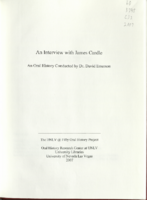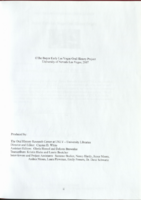Search the Special Collections and Archives Portal
Search Results

Transcript of interview with Richard Caldwell by Lloyd Henderson, March 06, 1980
Date
1980-03-06
Archival Collection
Description
Las Vegas history 1953-1980. Migration to Las Vegas from Louisiana. Personal history: family, occupation(s), and education. Westside. Development of race relations in Las Vegas. Residential segregation. Discrimination of blacks: no better than the South. Inequality of employment opportunities. Development of the Strip. Black entertainers.
Text

Transcript of interview with Richard Caldwell F. Sr. by Melvin Thompson, March 11, 1981
Date
1981-03-11
Archival Collection
Description
On March 11, 1981, Melvin Thompson interviewed Richard F. Caldwell Sr. (b. 1919 in New Orleans, Louisiana) about his experiences living in Las Vegas, Nevada for over 49 years. The interview begins with Caldwell discussing his family and what brought him to Las Vegas. He then talks about working at the Nevada Test Site, the hotels and casinos that were built on the Strip, his experience working at some of those properties, and the way of life in Las Vegas in the 1940s and 1950s. The two also discuss politics, religion, and recreational gambling in the city. The interview finalizes with Caldwell’s account of the Westside of Las Vegas, African American entertainers who came to town to perform, and a brief mention of many specific historical sites in the city.
Text

Transcript of interview with Bob Campagna by Kathleen Neumann, March 17, 1978
Date
1978-03-17
Archival Collection
Description
General Las Vegas history, Sahara and Charleston, when UNLV was first built, personal awards, Lorenzi Park, Newspapers. City Sanitation, power, and telephone. Church and religion, personal and family history.(Interview on tape inaudible).
Text

Transcript of interview with Sigrid Capel by Michael McKenna, February 10, 1980
Date
1980-02-10
Description
(Folder contains very good photos) Family and personal history focusing on growing up in Ely, NV, including leisure activities. Living through the Depression: banks closing; unemployment. Agricultural Extension Service. Cattle and drought in northern Nevada during the 1930s. Witness to the 1936 Berlin Olympic Games. Description of journey from Ely to Norway. Employment history. Gaming Control Board and the Black Book Occupations whilst in Las Vegas. [File includes personal photographs and news clippings]
Text

Transcript of interview with Vernon Caples by Cheryl Caples, February 25, 1979
Date
1979-02-25
Archival Collection
Description
Narrator b.1891. Las Vegas history from 1942 to 1979. Las Vegas airfield (Nellis). Prostitution. Hoover (Boulder) Dam: two anecdotes. Effect of WWII on Las Vegas. Hotel/casinos during the 1940s and 1950s. Leisure activities. Eldorado Festival. Lorenzi Park. BMI Plant. Retirement in Las Vegas.
Text

Transcript of interview with James Cardle by Dr. David Emerson, April 25, 2006
Date
2006-04-25
Archival Collection
Description
James Cardle is from Brainerd, a small town in central Minnesota. He grew up in a rural area with emphasis on outdoor fun. He attended Catholic grade school in Brainerd and a boarding high school in Prairie du Sac, Wisconsin. James earned an undergraduate degree at Holy Cross in western Massachusetts, and a Ph D in Civil Engineering from the University of Minnesota. He did research (physical experiments and numerical modeling) at St. Anthony Falls Hydraulic Laboratory, created a computer program that was used in the design of many large storm sewer systems around the country, and did consulting work on the side. Dr. Cardle came to UNLV in August of 1985 and began teaching a class on wastewater treatment. He was one of a small group of professors who worked hard to prepare for ABET accreditation. James was a member of the curriculum committee, did research on the Yucca Mountain project, and also worked on setting up a master's program. He wrote a proposal for the Ph.D. program in civil engineering which ended up being approved. James left UNLV to pursue a law degree at University of Notre Dame. Today he works as a patent attorney in Minneapolis-St. Paul. In 2006, he began acting as intellectual property counsel to UNLV on a part-time basis, giving him an opportunity to come back to Las Vegas and the university a couple of times each year.
Text

Transcript of interview with William Carlson by Alice Brown, March 19, 1980
Date
1980-03-19
Archival Collection
Description
On March 19, 1980, Alice Brown interviewed Dr. William Carlson (born 1914 in Sandstone, Minnesota) about his experience working at the University of Nevada, Las Vegas (UNLV). Carlson, who joined UNLV in 1957, provides his accounts on the history of the university library. The first part of the interview involves a discussion of the beginnings of the library from the location of Las Vegas High School to Maude Frazier Hall and its eventual move to Archie Grant Hall. Carlson also talks about some of the first librarians who were a part of the library, the funding and donations used to build and develop it, and the eventual construction and architecture of the James R. Dickinson Library. The two also discuss the first graduation of the university, the work it took to get students registered for classes in early days, and some of the overall changes over the years at the university.
Text

Transcript of interview with Marianne Carpenter by James D. Campbell, March 02, 1977
Date
1977-03-02
Archival Collection
Description
James D. Campbell interviews Las Vegas native, Marianne Carpenter (born in 1929) at the Environmental Protection Agency (EPA) office, located at the University of Nevada, Las Vegas. During the interview Marianne recalls the crash of Carol Lombard’s plane, the early above ground atomic tests, pollution and other social and environmental occurrences that have taken place in Las Vegas. Marianne also discusses the Helldorado Parade, the Downtown area and the Mesquite Club. Lastly, she offers an overview of her experience working for Nellis Air Force Base and her current job at the EPA
Text

Transcript of interview with Helen Daseler by Claytee White, October 9, 2007
Date
2007-10-09
Archival Collection
Description
In this interview, Helen Daseler shared memories of mining work in Colorado, living in Europe, and working for the U.S. government, in addition to opening the "Las Vegas Day School". Helen was born in 1929 in Newton, Iowa. She matriculated at George Washington University but earned her degree from the University of California Santa Barbara. After graduation Helen married Jack Daseler who joined the "Lighter-Than- Air Program with the Navy and flew blimps along the Pacific Coast, Atlantic Coast and South America. Later, Jack worked as a teaching principal in France and Germany where their three children were born. Helen and Jack, both certified teachers, moved to Las Vegas, Nevada, 47 years ago and started the Las Vegas Day School in a Unitarian Fellowship building on Bond Road (Tropicana). The initial class started with 14 students. Helen taught kindergarten the first year, and Jack assumed the administrative and management duties. As the nineteen seventies approached, they played a major role with school integration in Las Vegas. Since Jack, the daily operations of the school are performed by the three sons, Neil, Jack, and Frank. Helen is retired and lives in Las Vegas.
Text

Transcript of interview with Chet Carrigan by Robert Kahre, February 17, 1981
Date
1981-02-17
Archival Collection
Description
On February 17, 1981, Robert Kahre interviewed Chet Carrigan (born 1912 in Texas) about his experience living in Las Vegas, Nevada. Carrigan first talks about his background in construction as well as some of his experiences in the Sheriff’s Posse before describing the major events and changes of Las Vegas that he witnessed. Carrigan also talks about his family, the effects of the Great Depression on the city, the flooding problem, and the building of Hoover Dam. He also describes the first schools in Las Vegas, means of transportation, his laundry business, and his experience on the volunteer fire department. The end of the interview involves a discussion of topics including the first movie theaters, Cashman Field, underground water, the railroads, and Carrigan’s thoughts on the future of Las Vegas.
Text
Pagination
Refine my results
Content Type
Creator or Contributor
Subject
Archival Collection
Digital Project
Resource Type
Year
Material Type
Place
Language
